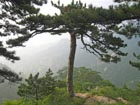
Isolated tree in mountain habitat [Arboles Gigantes, 2017.01.21 , Facebook post].

Isolated tree in mountain habitat [Haruo Kosugi, 2020.02.13, Facebook post].
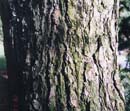
Bark on an ornamental specimen in Seattle (USA) [C.J. Earle, 1999.02.28].

Mature cone on a cultivated tree of var. mukdensis [Scott Carver, 2017.10.26, Facebook post].
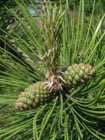
Shoot, foliage, and immature cones on a cultivated plant [József Tóth, 2016.11.19, Facebook post].
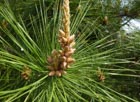
Foliage, shoot, and immature pollen cones [Paco Garin, 2018.04.08, Facebook post].
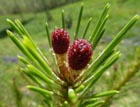
Receptive female cones on a cultivated plant [Paco Garin, 2018.04.08, Facebook post].

Cultivated seedling - or maybe old enough to be called a sapling [Berrington Gardens, 2020.04.25, Facebook post].

Cone and winged seeds [Волонтеры дендрария ГБС, 2019.01.20, Facebook post].

Seed harvested for ex situ cultivation [James Zhang, 2020.01.05, Facebook post].

Pinus tabuliformis
Carrière 1867
Common names
Chinese red pine; 油松 you song [Chinese].
Taxonomic notes
This is one of many species in Pinus subsection Pinus. For a long time, essentially until the end of the 20th Century, not much was known about it (even its name; many older texts describe "Pinus tabulaeformis"), but in this century it has come under closer scrutiny and its ecology, culture and systematics are now relatively well understood. Molecular analysis has placed it in a clade with other Asian pines in the subsection, P. densata, P. henryi, P. hwangshanensis, P. kesiya, P. luchuensis, P. thunbergii and P. yunnanensis (Geada Lopez et al. 2002, Gernandt et al. 2005). Of those, P. henryi was formerly treated as a variety. This treatment follows Farjon (2010) in segregating P. henryi and recognizing three varieties of P. tabuliformis:
- Pinus tabuliformis Carrière var. tabuliformis. Type not designated. Syn: P. tabuliformis var. brevifolia S.Y. Wang & C.L. Chang 1981.
- Pinus tabuliformis Carrière var. mukdensis (Uyeki ex Nakai) Uyeki 1925. Type, North Korea, locale not stated; H. Uyeki 2350. Syn: P. mukdensis Uyeki ex Nakai 1919; P. tabuliformis subsp. mukdensis (Uyeki ex Nakai) Businsky 1999.
- Pinus tabuliformis Carrière var. umbraculifera T.N. Liou & Q.L. Wang 1958. Type, China: Hebei: Anshan Shi, Chin. coll. n.v. No synonyms.
Pinus densata has also been called a variety of this species (Silba 1986).
Description
Trees to 30 m tall and 120 cm dbh, usually with a single (sometimes forked) trunk and spreading or downcurving branches forming a domed or flat-topped crown. Bark on mature trees scaly, fissured, breaking into large irregular plates, pale brown weathering grey, flaking in small or large chips. Twigs stout, becoming rough with pulvini after shedding leaves, glabrous, new shoots yellow-brown, pale brown or slightly glaucous, turning light brown to gray-brown or gray. Buds oblong, acute; terminal bud to 20 mm long, slightly resinous; cataphylls appressed, pale brown. Leaves in fascicles of 2(-3), persisting 2-3 years, spreading, held in a 10-15 mm long, persistent basal sheath; 6-15 cm long, straight or curved, rigid, 1-1.5 mm thick, often slightly twisted, dark green; apex acute or acuminate; stomata in fine lines on all surfaces. Pollen cones short cylindrical, ca. 20 mm long, yellow when ripe. Seed cones solitary or in pairs, short pedunculate, opening soon when ripe but usually persisting a few years, ovoid, near-symmetrical, 5-8.5 × 3.5-5 cm wide. Seed scales woody, stiff, oblong to obovate, spreading wide, often recurving; apophyses prominently raised, variously shaped, transversely keeled, ripening from green to yellowish brown or pale brown; umbo pyramidal, armed with a sharp, curved prickle. Seeds ovoid-oblong, 6-8 × 4-5 mm, pale brown, mottled; wing 12-18 mm long, light brown or grey-brown (Farjon 2010). The varieties are distinguished as follows:
- Var. tabuliformis has gray or brown-gray bark arranged in large plates; the new shoots are yellowish or pale brown, and not glaucous. Leaves are stiff, 1.2-1.5 mm thick (Farjon 2010).
- Var. mukdensis has dark gray, longitudinally fissured bark, leaves 1-1.2 mm thick, and seed cones 4-8.5 cm long that open up to 7 cm wide (Farjon 2010).
- Var. umbraculifera usually has a trunk forked below the crown; new shoots are yellowish or pale brown, not or only slightly glaucous; leaves are stiff, 1.2-1.5 mm thick (Farjon 2010).
Distribution and Ecology
China and Korea. The type variety is recorded from China: Anhui, Beijing, Gansu, Hebei, Henan, Hubei, Jilin, Liaoning, Nei Mongol, Ningxia, Qinghai, Shaanxi, Shandong, Shanxi, Sichuan and Yunnan. Var. mukdensis is recorded from China: Liaoning and North Korea. Var. umbraculifera is recorded from China: Hebei. This species is most common in temperate conifer forests at middle elevations in the hills and mountains, but occurs at elevations of 100-2600 m. It is most typical on dry, sunny slopes and hills where it can outcompete competition from broad-leaved trees with less tolerance for moisture stress. It is often an early-seral species and in such setting is commonly mixed with deciduous shrubs and trees, often giving way to these angiosperms. Due to the species' importance as a source of timber, though, there are also many stands managed to achieve P. tabuliformis dominance (Farjon 2010). In Shanxi, P. tabuliformis was found to form mostly pure stands. In mixed stands, common associates were Quercus wutaishanica and Populus davidiana; no other conifers were noted (Qin et al. 2017).
Due to its wide distribution, it is rated "Least Concern" for conservation.
Hardy to Zone 5 (cold hardiness limit between -28.8°C and -23.3°C) (Bannister and Neuner 2001).
Remarkable Specimens
The oldest reported living tree was 402 years old (crossdated) in 2009, growing on Xiaolongshan in Gansu (Fang et al. 2012). This was one result of the first dendrochronological study of Pinus tabuliformis, using cores from 29 trees to develop a 400-year reconstruction of monsoonal precipitation.
Ethnobotany
P. tabuliformis is widely used in commercial forestry in China, mainly for its hard, strong, straight-grained timber, useful for construction, mining, railroad ties, bridges, boatbuilding, and other uses requiring a strong timber. There is also some use for plywood and fibreboard. The bark and leaves yield resin for turpentine and tannin for the tanning of hides. Essential oils distilled from the leaves and the pollen are used in traditional Chinese medicine. In China, this species is commonly planted in forestry plantations, and occasionally as an ornamental tree. Outside China it remains fairly uncommon. No cultivars have been selected and named (Farjon 2010, CABI International 2020).
Observations
A rare old-growth forest can be seen on the heights of Wudang Shan in northern Hubei (ca. 32° 28' N, 111° 8' E), where it grows as a forest dominant along with Quercus aliena (del Tredici 1995).
Remarks
The epithet is from the Latin tabula (plank) and formare (to fabricate), referring to this species' importance as a source of timber.
Pests and pathogens commonly associated with P. tabuliformis include Cronartium flaccidum (Scots pine blister rust), Dendroctonus valens (red turpentine beetle), Dendrolimus tabulaeformis (Chinese pine caterpillar), and Mycosphaerella gibsonii (needle blight of pine). It is also a minor host of Candidatus phytoplasma pini (pine witches'-broom phytoplasma), Coleosporium asterum (needle cast: red pine), Cronartium quercuum (pine-oak rust), and Fomitopsis pinicola (brown crumbly rot). It also has a bark beetle, Ips sexdentatus (six-toothed bark beetle) (CABI International 2020).
Citations
CABI International. 2020. Invasive Species Compendium: Pinus tabuliformis (chinese pine). https://www.cabi.org/isc/datasheet/41729, accessed 2020.05.06.
del Tredici, Peter et al. 1995. Plant collecting on Wudang Shan. Arnoldia 55(1): 12-20.
Fang, Keyan, Xiaohua Gou, Fahu Chen, David Frank, Changzhi Liu, Jinbao Li, and Miklos Kazmer. 2012. Precipitation variability during the past 400 years in the Xiaolong Mountain (central China) inferred from tree rings. Climate Dynamics 39:1697-1707.
Farjon, Aljos. 2010. A Handbook of the World's Conifers. Leiden, Netherlands: Brill Academic Publishers.
Geada López, G., K. Kamiya, and K. Harada. 2002. Phylogenetic relationships of diploxylon pines (Subgenus Pinus) based on plastid sequence data. International Journal of Plant Sciences 163(5):737–747.
Gernandt, D. S., G. Geada López, S. O. García, and A. Liston. 2005. Phylogeny and Classification of Pinus. Taxon 54(1):29.
Qin, H., G. Dong, Y. Zhang, F. Zhang, and M. Wang. 2017. Patterns of species and phylogenetic diversity of Pinus tabuliformis forests in the eastern Loess Plateau, China. Forest Ecology and Management 394:42–51.
See also










